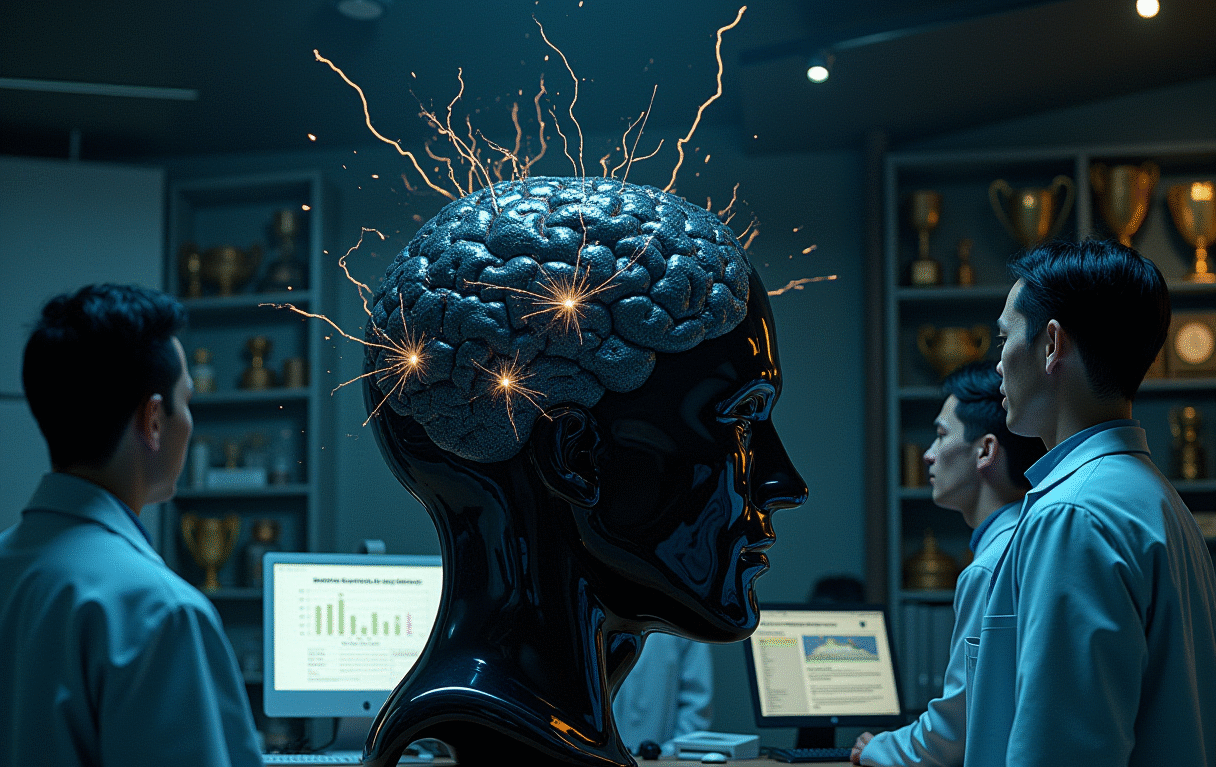Why Brain Stimulation Studies Reveal More About Scientists Than the Brain
In today’s scientific ecosystem, success is no longer just about discovery—it’s about khả năng hiển thị. Academic careers rise not on insight alone, but on metrics: publication counts, citation indexes, media attention, and grant acquisition. This environment has created a powerful psychological and institutional loop in which the reward is not understanding, but recognition. A striking example of this dynamic can be seen in a recent brain stimulation study published in Nature and widely reported by Live Science under the headline: “Zapping the brain may help boost math skills, study hints”.
The study suggests that mild electrical stimulation applied to the scalp can improve arithmetic learning. But beneath the scientific polish lies a troubling epistemological question: what are we really learning—and for whom?
The Promise and the Problem
The study in question uses transcranial random noise stimulation (tRNS) to apply weak electrical current over large regions of the brain—specifically, the dorsolateral prefrontal cortex (dlPFC) and posterior parietal cortex (PPC). After five days of exposure, some students showed improved performance in calculation tasks. These modest statistical gains were celebrated as breakthroughs in cognitive enhancement.
But what do such findings actually reveal?
Not much about how the brain performs mathematics, and even less about the nature of learning or reasoning. Instead, they reveal how modern research often prioritizes perturbation that performs over knowledge that explains.
The Scale Fallacy: Nudging Giants to Fix a Microchip
Let’s examine the absurdity more closely. A single neuron is about 10 microns wide. The tRNS electrodes used in the study cover surface areas thousands to millions of times larger. These methods bathe vast cortical territories in electrical noise with little to no control over which circuits are actually being influenced.
The underlying assumption is that cognitive functions like “calculation” are localized and that broad cortical excitation will selectively enhance them. But math is not a localized skill. It recruits distributed brain systems: numerical estimation, working memory, symbolic reasoning, and verbal recall. Enhancing one region is unlikely to cause specific, meaningful improvements. If anything, it’s like watering your whole backyard to try and help a single flower bloom.
Đây là scale fallacy: attempting to fine-tune precise cognitive abilities using a coarse, imprecise instrument. It reflects not a breakthrough in neuroscience, but a breakdown in methodological reasoning.
The Black Box Analogy
To highlight the conceptual error, imagine an alien attempting to understand a sealed microchip. It applies random electrical signals to the outer casing and notices that occasionally, the chip emits heat or a light flickers. Would the alien conclude it understands the chip’s logic or architecture? Of course not. It has discovered a correlation—an output reaction to input noise—without uncovering any internal structure.
This is precisely what tRNS studies accomplish. They produce behavioral perturbations without offering explanatory power. They simulate causality while hiding the mechanics.
The Recognition Loop: How Science Imitates Its Own Subject
Eidoism defines the loop of recognition as the recursive mechanism that drives human performance in pursuit of being seen, validated, and admired. Ironically, science itself is now caught in this very loop.
- A researcher designs a study that produces a statistically significant effect.
- A journal publishes the result to boost impact factor.
- Media outlets amplify the story with sensationalist language.
- Universities showcase the work for public relations.
- Grant committees fund more of the same.
This cycle doesn’t reward deep insight. It rewards novelty, drama, and performance. The research becomes less about understanding the brain and more about stimulating the academic-industrial complex.
In this context, brain stimulation experiments are not advancing science. They’re performing it.
What Is Actually Being Stimulated?
Let’s ask the deeper question: what is really being stimulated in these studies?
Not the specific neurons responsible for learning—but the broader ecosystem of institutional desire. The behavior being modified is not arithmetic ability, but recognition behavior across the academic hierarchy.
The experiment stimulates:
- Journals hungry for eye-catching results.
- Scientists seeking career advancement.
- Universities chasing prestige.
- Investors seeking neurotech hype.
The brain becomes a passive proxy for institutional performance metrics.
Beyond the Loop: A Call for Conceptual Integrity
A meaningful neuroscience must begin with conceptual humility. It must reject the illusion that emergent cognitive functions—like reasoning, meaning, or calculation—can be enhanced through superficial stimulation. It must resist the temptation to confuse modulation with understanding.
The tools of neuroscience must match the scale and complexity of the phenomena they target. And until that is possible, the field must acknowledge the limits of its reach—and the inflation of its claims.
Science Must Study Itself
As long as neuroscience performs experiments designed more for recognition than revelation, it will remain trapped in a feedback loop of symbolic success. The use of brain stimulation to “improve math learning” is not just scientifically flimsy—it is epistemologically hollow. It distracts from the real work of understanding the mind, and reflects a deeper crisis in how science defines value.
Until we confront the loop of recognition that governs research itself, we will keep zapping the brain—and calling it discovery—while the actual architecture of thought remains unknown, untouched, and untouched.


